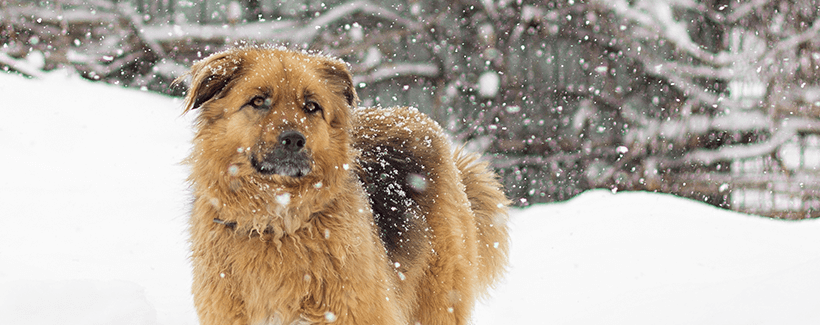Pet Myths – Cold Weather Pet Care – Well Pet Blog | Lambert Vet Supply

PAWZ® Dog Boots
PAWZ Dog Boots are designed from natural rubber so they stretch to fit and stay on your dog.
One of the most common misconceptions regarding winter pet safety is that once our animal friends grow their winter coats, they have everything they need to survive the cold months. Their fur’s nice and thick, what do they have to fear? Well, as it turns out, quite a bit. Sure, a winter coat provides enhanced protection against the chill, but sometimes that’s not enough. Not to mention, some wintertime hazards come in forms which have little to do with temperature. Here are a few myths of which you should be aware.
Winter Pet Safety Myth 1: Thicker coats provide all the warmth pets need in winter.
Let’s address this one right off the bat. Yes, most mammalian pets – especially cats and dogs – naturally grow thicker fur during autumn and winter for extra protection against the cold. However, at the same time, it’s not a full-proof defense. On days that are particularly cold – days where temperatures sink below zero – a winter coat will only offer some warmth. Odds are, your pet will still feel the chill. Days with a nasty wind are even worse.
How about snow? Doesn’t a winter coat keep that out? Well, only to an extent. If your dog plays around in the snow for an extended period of time, the snow will dampen their fur. A wet coat of fur, in turn, increases the rate at which your pet expels body heat.
So what do we recommend? On days where it’s bitterly cold – when the temperature is below zero, when the wind is whipping around – let your pet outside for just a few minutes at a time. Make sure they always have access to some kind of shelter – say, a doghouse filled with straw or equipped with a heating pad (having a plastic flap covering the entrance also helps keep out wind and precipitation). Brush the snow off their fur when they come in. All of this will help keep your furry friend warm in the winter.
Related Article: Keeping Warm »
Winter Pet Safety Myth 2: Pets don’t need foot protection in winter because they have paw pads.
While a winter coat does provide extra insulation for an animal’s body during the winter, it offers no defense for their feet. But hold on! Dogs and cats have that hard padding on the bottoms of their paws. Isn’t that protection against things like snow and ice? Well, yes. But, again, it’s not full-proof.
One of the most painful things which can happen to a pet during wintertime is intense pain in the feet. One of the ways this can happen is snow or ice becoming jammed in the narrow space between their toes. If left unattended, this can cause not only great agony but, worse still, cut off circulation and create gangrene.
On those especially harsh winter days, once again we recommend limiting your pet’s outdoor time. We also have for sale little booties which you can put on their feet. This extra insulation helps keep out snow. Plus, they’re really, really cute!
Save now on cold weather products for your pets! »
Winter Pet Safety Myth 3: Pets have all the survival instincts they need for winter.
Here’s an often overlooked element of winter animal safety. It goes without saying that animals are biologically equipped for survival in the outdoors – much more than humans. They have natural protection on their feet, they have superior digestive systems, and most of them know how to swim by instinct. That said: your animal’s natural instinct to seek out fluids when they’re thirsty can potentially backfire in the winter. Especially if they’re hanging out on the driveway and they confuse antifreeze-melted slush for clean water. Chemicals used to melt snow and ice often contain toxic ingredients which can fatally poison your pet. Even if they don’t drink it directly, walking across the slush can irritate their paw pads. A pet’s natural instinct is then to start licking their feet until the irritation goes away. Once they lick the chemical-laden residue off their feet, they risk being poisoned all over again.
In addition to keeping your pets off the driveway when it’s being de-iced, it would be a good idea to invest in a heated water bowl. Make sure it stays activated (and remains filled with water) every time your pet goes outdoors.
Winter Pet Safety Myth 4: Pets don’t run away from home in the winter.
Never, ever make this assumption. As any animal shelter worker could tell you, pets can become lost in any season of the year. In fact, snow and ice covering landmarks and familiar scents on the ground can make it difficult for a wandering animal to find its way back home. If you haven’t done so already, consider microchipping your pet. That way, if they do become lost and someone finds them, it’ll be much easier for them to be reunited with their owners.
